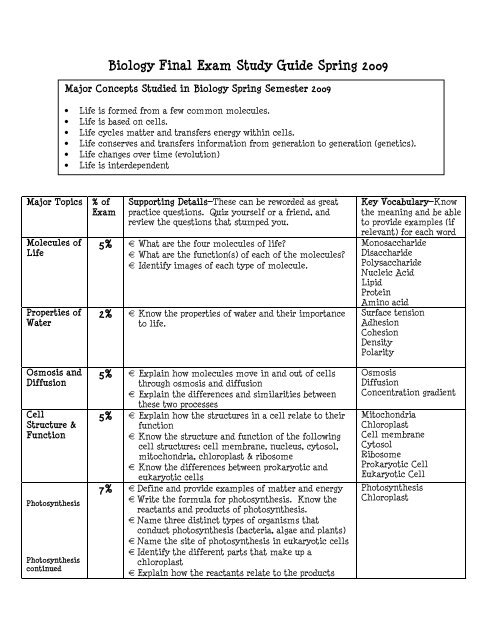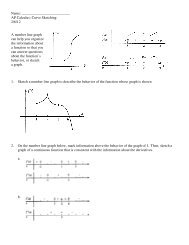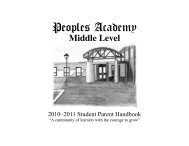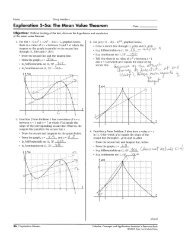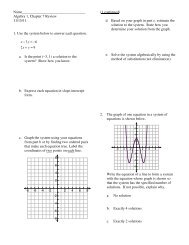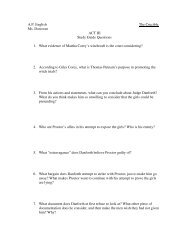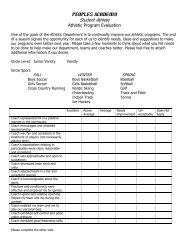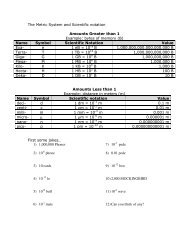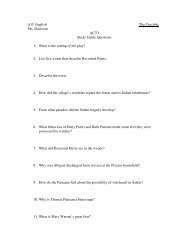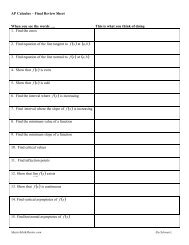Biology Final Exam Study Guide Spring 2009
Biology Final Exam Study Guide Spring 2009
Biology Final Exam Study Guide Spring 2009
- No tags were found...
You also want an ePaper? Increase the reach of your titles
YUMPU automatically turns print PDFs into web optimized ePapers that Google loves.
<strong>Biology</strong> <strong>Final</strong> <strong>Exam</strong> <strong>Study</strong> <strong>Guide</strong> <strong>Spring</strong> <strong>2009</strong>Major Concepts Studied in <strong>Biology</strong> <strong>Spring</strong> Semester <strong>2009</strong>• Life is formed from a few common molecules.• Life is based on cells.• Life cycles matter and transfers energy within cells.• Life conserves and transfers information from generation to generation (genetics).• Life changes over time (evolution)• Life is interdependentMajor Topics % of<strong>Exam</strong>Molecules ofLifeProperties ofWaterSupporting Details—These can be reworded as greatpractice questions. Quiz yourself or a friend, andreview the questions that stumped you.5% € What are the four molecules of life?€ What are the function(s) of each of the molecules?€ Identify images of each type of molecule.2% € Know the properties of water and their importanceto life.Key Vocabulary—Knowthe meaning and be ableto provide examples (ifrelevant) for each wordMonosaccharideDisaccharidePolysaccharideNucleic AcidLipidProteinAmino acidSurface tensionAdhesionCohesionDensityPolarityOsmosis andDiffusionCellStructure &FunctionPhotosynthesisPhotosynthesiscontinued5% € Explain how molecules move in and out of cellsthrough osmosis and diffusion€ Explain the differences and similarities betweenthese two processes5% € Explain how the structures in a cell relate to theirfunction€ Know the structure and function of the followingcell structures: cell membrane, nucleus, cytosol,mitochondria, chloroplast & ribosome€ Know the differences between prokaryotic andeukaryotic cells7% € Define and provide examples of matter and energy€ Write the formula for photosynthesis. Know thereactants and products of photosynthesis.€ Name three distinct types of organisms thatconduct photosynthesis (bacteria, algae and plants)€ Name the site of photosynthesis in eukaryotic cells€ Identify the different parts that make up achloroplast€ Explain how the reactants relate to the productsOsmosisDiffusionConcentration gradientMitochondriaChloroplastCell membraneCytosolRibosomeProkaryotic CellEukaryotic CellPhotosynthesisChloroplast
CellularRespiration€ Identify the process by which carbon dioxide movesfrom the air into the cell6% € Write the formula for cellular respiration€ Name the site of cellular respiration in eukaryoticcells€ Explain the purpose of ATP in cells€ Explain what happens to the carbon dioxide that isproduced as a result of cellular respiration€ Identify the source of energy in cellular respirationand identify the chemical bonds that hold theenergyMitochondriaATPMitosis 5% € All cells come from pre-existing cells€ Explain that in non-dividing cells, DNA exists inthe form of chromatin. In cells preparing to divide,DNA is copied and condensed into chromosomes.€ Explain the structure of the chromosome and howit relates to cell division.€ The purpose of mitosis is to produce identical,diploid cells. This explains part of the cell theorywhich states that “all cells come from preexistingcells”.€ Know the stages of mitosis, the key events in eachstage and be able to recognize images of each stage€ Be able to explain how the total number ofchromosomes in the cell changes over the course ofmitosis.Meiosis 10% € Explain the purpose of meiosis€ List key differences between mitosis and meiosis€ Explain how the total number of chromosomes inthe cell changes over the course of meiosis€ Explain how mistakes can occur in meiosis and theimplications of these mistakesMitosisInterphaseProphaseMetaphaseAnaphaseTelophaseChromosomeCentromereMeiosisDiploidHaploidMendelianGenetics10% € Solve genetics problems€ Identify the difference between dominant andrecessive traits and homozygous and heterozygousindividuals.HomozygousHeterozygousDominant AlleleRecessive AlleleGeneTraitHeredityStructureandFunction ofDNA15% € Know the basic chemical structure of the DNAmolecule—three component parts€ Know the major scientists who worked to discoverthe structure of the DNA molecule. Know thesignificance of each scientists discovery€ Complementary base pairing in DNA. Know theNucleic AcidNucleotide BaseAdenineThymineCytosineGuanine
CentralDogmaEvolution—Evidence &Mechanismspairs of molecules€ How does DNA replicate?15% € The central dogma of molecular biology can besummarized as: DNARNAProteinTrait. Beable to explain what this means and how thecentral dogma works through transcription andtranslation.€ Know the differences in structure and functionbetween DNA, mRNA and tRNA€ Know the difference between an amino acid,polypeptide and protein€ Explain the major outcomes of transcription andtranslation€ Explain the relationship between DNA and proteins€ Identify several functions that proteins have in anorganism15% € Interpret the different types of evidence forevolution and provide examples of each.€ Interpret data and create an accurate cladogrambased on the characteristics of a set of organism€ Explain what is meant by the term, “commonancestor”€ Explain how each of the mechanisms of evolutioncan cause a species to change over timeRosalind FranklinWatson and CrickDNAmRNAtRNAcodonAnti-codonAmino acidTranscriptionTranslationPolypeptideBiogeographyHomologous structuresVestigial StructuresComparative AnatomyEmbryologyFossil EvidenceNatural SelectionSexual SelectionMutationSymbiogenesis<strong>Study</strong> Tips—How to Prepare for the <strong>Final</strong> <strong>Exam</strong>€ Create a vocabulary study guide, then quiz yourself or a friend€ Review the list in the center column. Transform each statement into aquestion, write out the answer to each question, then quiz yourself or a friend.€ Review your study sheet every day€ Review old tests and quizzes€ Practice, practice, practice. Review, review, review.


